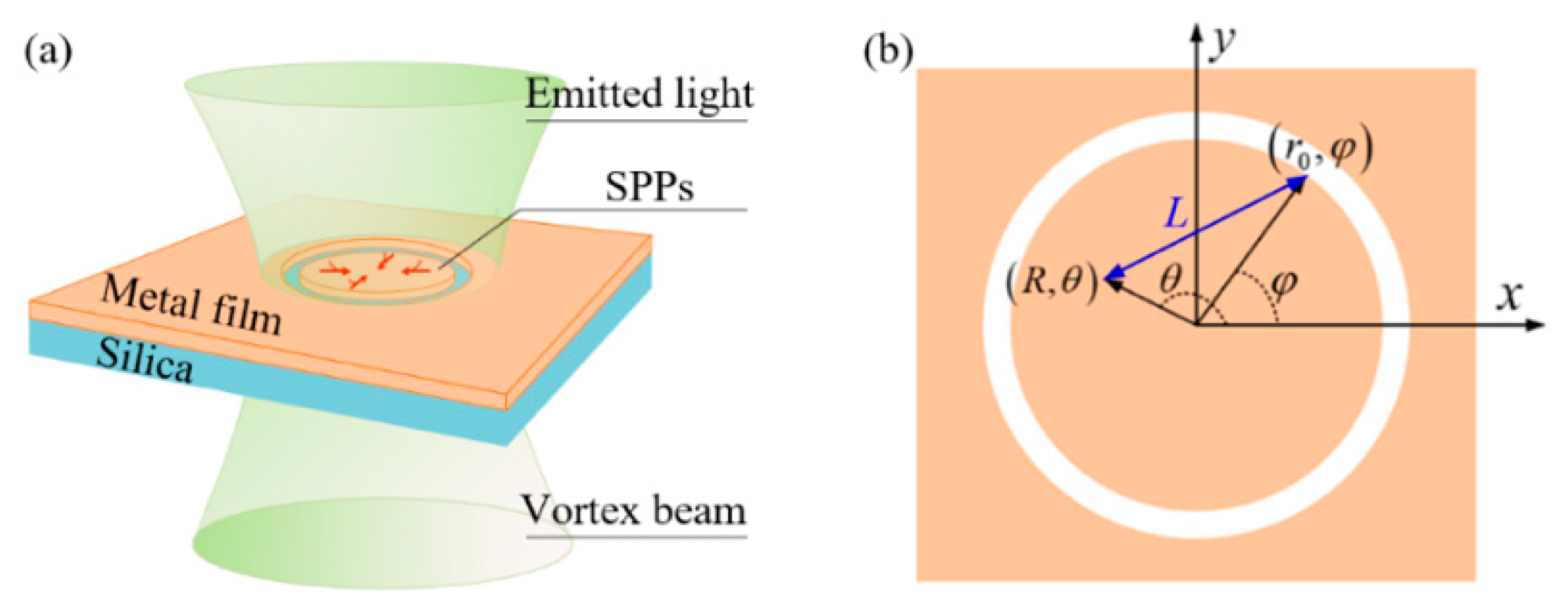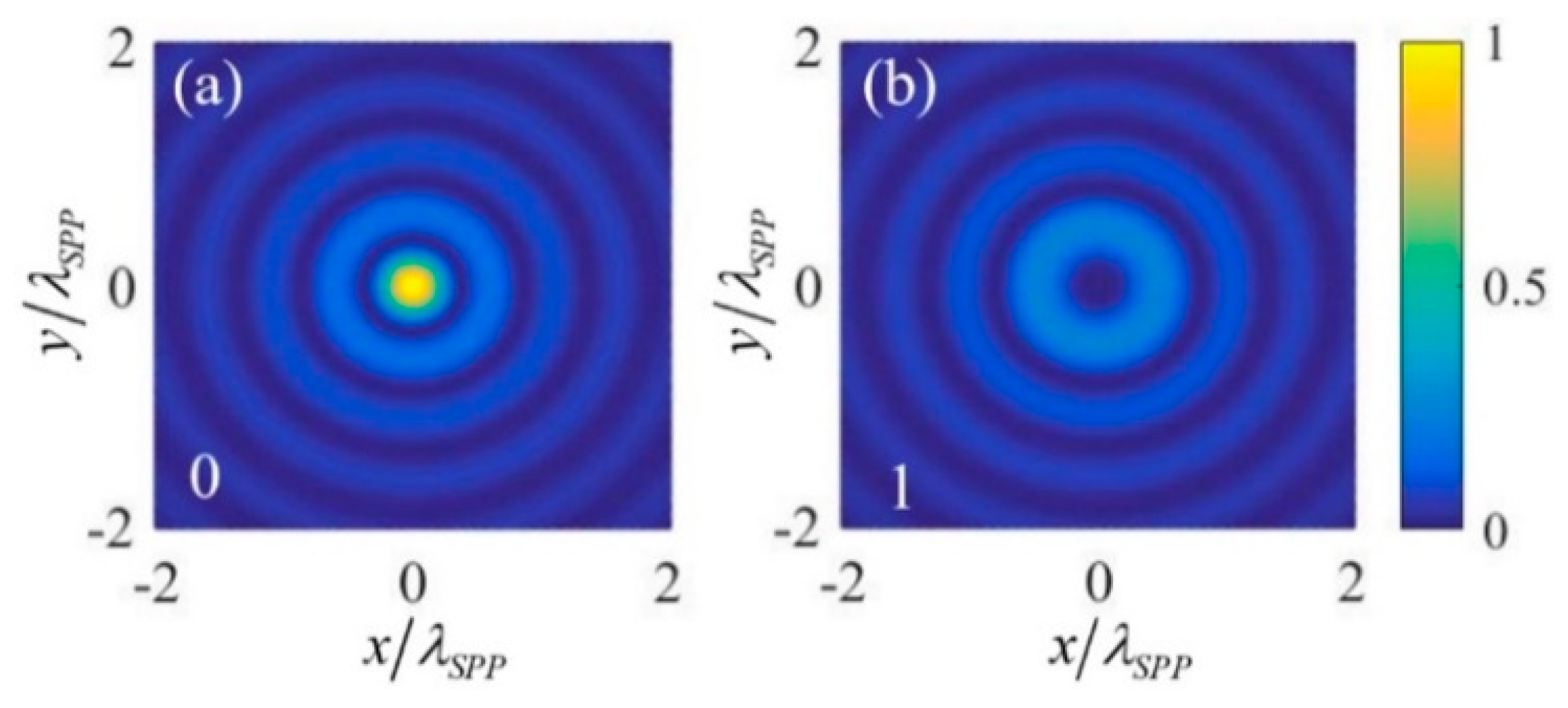Vortex Beam Encoded All-Optical Logic Gates Based on Nano-Ring Plasmonic Antennas
Abstract
1. Introduction
2. Interactions between Light and Surface Plasmon Polaritons (SPPs) on Nano-Ring Plasmonic Antennas
3. Design and Discussion
3.1. OR and AND Logic Gates
3.2. NOT Logic Gate
3.3. NOR and NAND Logic Gates
3.4. XNOR Logic Gate
4. Conclusions
Author Contributions
Funding
Conflicts of Interest
References
- Kirchain, R.; Kimerling, L. A roadmap for nanophotonics. Nat. Photonics 2007, 1, 303. [Google Scholar] [CrossRef]
- Sasikala, V.; Chitra, K. All optical switching and associated technologies: A review. J. Opt. 2018, 47, 307–317. [Google Scholar] [CrossRef]
- Qin, J.; Lu, G.; Sakamoto, T.; Akahane, K.; Yamamoto, N.; Wang, D.; Wang, C.; Wang, H.; Zhang, M.; Kawanishi, T.; et al. Simultaneous multichannel wavelength multicasting and XOR logic gate multicasting for three DPSK signals based on four-wave mixing in quantum-dot semiconductor optical amplifier. Opt. Express 2014, 22, 29413–29423. [Google Scholar] [CrossRef] [PubMed]
- Salmanpour, A.; Mohammadnejad, S.; Bahrami, A. All-optical photonic crystal AND, XOR, and OR logic gates using nonlinear Kerr effect and ring resonators. J. Mod. Opt. 2015, 62, 693–700. [Google Scholar] [CrossRef]
- Almeida, V.R.; Barrios, C.A.; Panepucci, R.R.; Lipson, M. All-optical control of light on a silicon chip. Nature 2004, 431, 1081. [Google Scholar] [CrossRef]
- Nozaki, K.; Tanabe, T.; Shinya, A.; Matsuo, S.; Sato, T.; Taniyama, H.; Notomi, M. Sub-femtojoule all-optical switching using a photonic-crystal nanocavity. Nat. Photonics 2010, 4, 477. [Google Scholar] [CrossRef]
- Ota, M.; Sumimura, A.; Fukuhara, M.; Ishii, Y.; Fukuda, M. Plasmonic-multimode-interference-based logic circuit with simple phase adjustment. Sci. Rep. 2016, 6, 24546. [Google Scholar] [CrossRef]
- Plum, E.; MacDonald, K.F.; Fang, X.; Faccio, D.; Zheludev, N.I. Controlling the optical response of 2D matter in standing waves. ACS Photonics 2017, 4, 3000–3011. [Google Scholar] [CrossRef]
- Baranov, D.G.; Krasnok, A.; Shegai, T.; Alù, A.; Chong, Y. Coherent perfect absorbers: Linear control of light with light. Nat. Rev. Mater. 2017, 2, 17064. [Google Scholar] [CrossRef]
- Roger, T.; Vezzoli, S.; Bolduc, E.; Valente, J.; Heitz, J.J.F.; Jeffers, J.; Soci, C.; Leach, J.; Couteau, C.; Zheludev, N.I.; et al. Coherent perfect absorption in deeply subwavelength films in the single-photon regime. Nat. Commun. 2015, 6, 7031. [Google Scholar] [CrossRef]
- Xomalis, A.; Demirtzioglou, I.; Plum, E.; Jung, Y.; Nalla, V.; Lacava, C.; MacDonald, K.F.; Petropoulos, P.; Richardson, D.J.; Zheludev, N.I. Fibre-optic metadevice for all-optical signal modulation based on coherent absorption. Nat. Commun. 2018, 9, 182. [Google Scholar] [CrossRef] [PubMed]
- Papaioannou, M.; Plum, E.; Valente, J.; Rogers, E.T.F.; Zheludev, N.I. All-optical multichannel logic based on coherent perfect absorption in a plasmonic metamaterial. APL Photonics 2016, 1, 090801. [Google Scholar] [CrossRef]
- Cohen, M.; Zalevsky, Z.; Shavit, R. Towards integrated nanoplasmonic logic circuitry. Nanoscale 2013, 5, 5442–5449. [Google Scholar] [CrossRef] [PubMed]
- Fu, Y.; Hu, X.; Lu, C.; Yue, S.; Yang, H.; Gong, Q. All-optical logic gates based on nanoscale plasmonic slot waveguides. Nano Lett. 2012, 12, 5784–5790. [Google Scholar] [CrossRef] [PubMed]
- Wei, H.; Wang, Z.; Tian, X.; Käll, M.; Xu, H. Cascaded logic gates in nanophotonic plasmon networks. Nat. Commun. 2011, 2, 387. [Google Scholar] [CrossRef] [PubMed]
- Birr, T.; Zywietz, U.; Chhantyal, P.; Chichkov, B.N.; Reinhardt, C. Ultrafast surface plasmon-polariton logic gates and half-adder. Opt. express 2015, 23, 31755–31765. [Google Scholar] [CrossRef] [PubMed]
- Wei, H.; Li, Z.; Tian, X.; Wang, Z.; Cong, F.; Liu, N.; Zhang, S.; Nordlander, P.; Halas, N.J.; Xu, H. Quantum dot-based local field imaging reveals plasmon-based interferometric logic in silver nanowire networks. Nano Lett. 2010, 11, 471–475. [Google Scholar] [CrossRef]
- Lu, C.; Hu, X.; Yang, H.; Gong, Q. Chip-integrated ultrawide-band all-optical logic comparator in plasmonic circuits. Sci. Rep. 2014, 4, 3869. [Google Scholar] [CrossRef]
- Kumar, A.; Kumar, S.; Raghuwanshi, S.K. Implementation of XOR/XNOR and AND logic gates by using Mach–Zehnder interferometers. Opt.-Int. J. Light Electron Opt. 2014, 125, 5764–5767. [Google Scholar] [CrossRef]
- Malka, D.; Cohen, M.; Turkiewicz, J.; Zalevsky, Z. Optical micro-multi-racetrack resonator filter based on SOI waveguides. Photonics Nanostruct.-Fundam. Appl. 2015, 16, 16–23. [Google Scholar] [CrossRef]
- Yang, Z.; Fu, Y.; Yang, J.; Hua, C.; Zhang, J. Spin-encoded subwavelength all-optical logic gates based on single-element optical slot nanoantennas. Nanoscale 2018, 10, 4523–4527. [Google Scholar] [CrossRef] [PubMed]
- Deng, L.; Wang, H.; Wang, K. Quantum CNOT gates with orbital angular momentum and polarization of single-photon quantum logic. JOSA B 2007, 24, 2517–2520. [Google Scholar] [CrossRef]
- Lopes, J.H.; Soares, W.C.; Bernardo, B.D.L.; Caetano, D.P.; Canabarro, A. Linear optical CNOT gate with orbital angular momentum and polarization. Quantum Inf. Process. 2019, 18, 256. [Google Scholar] [CrossRef]
- Liu, H.; Teng, C.; Yang, H.; Deng, H.; Xu, R.; Deng, S.; Chen, M.; Yuan, L. Proposed phase plate for superimposed orbital angular momentum state generation. Opt. Express 2018, 26, 14792–14799. [Google Scholar] [CrossRef] [PubMed]
- Chen, M.; Gao, W.; Liu, H.; Teng, C.; Deng, S.; Deng, H.; Yuan, L. Polarization controllable generation of flat superimposed OAM states based on metasurface. Opt. Express 2019, 27, 20133–20144. [Google Scholar] [CrossRef]
- Yao, A.M.; Padgett, M.J. Orbital angular momentum: Origins, behavior and applications. Adv. Opt. Photonics 2011, 3, 161–204. [Google Scholar] [CrossRef]
- Lavery, M.P.J.; Speirits, F.C.; Barnett, S.M.; Padgett, M.J. Detection of a spinning object using light’s orbital angular momentum. Science 2013, 341, 537–540. [Google Scholar] [CrossRef]
- Allen, L.; Beijersbergen, M.W.; Spreeuw, R.J.C.; Woerdman, J.P. Orbital angular momentum of light and the transformation of Laguerre-Gaussian laser modes. Phys. Rev. A 1992, 45, 8185–8189. [Google Scholar] [CrossRef]
- Zhu, L.; Wang, J. Simultaneous generation of multiple orbital angular momentum (OAM) modes using a single phase-only element. Opt. Express 2015, 23, 26221–26233. [Google Scholar] [CrossRef]
- Marrucci, L.; Manzo, C.; Paparo, D. Optical spin-to-orbital angular momentum conversion in inhomogeneous anisotropic media. Phys. Rev. Lett. 2006, 96, 163905. [Google Scholar] [CrossRef]
- Beijersbergen, M.W.; Coerwinkel, R.; Kristensen, M.; Woerdman, J.P. Helical-wavefront laser beams produced with a spiral phaseplate. Opt. Commun. 1994, 112, 321–327. [Google Scholar] [CrossRef]
- Chen, S.; Cai, Y.; Li, G.; Zhang, S.; Cheah, K.W. Geometric metasurface fork gratings for vortex-beam generation and manipulation. Laser Photonics Rev. 2016, 10, 322–326. [Google Scholar] [CrossRef]
- Wang, Y.; Bao, W.S.; Bao, H.Z.; Zhou, C.; Jiang, M.S.; Li, H.W. High-dimensional quantum key distribution with the entangled single-photon-added coherent state. Phys. Lett. A 2017, 381, 1393–1397. [Google Scholar] [CrossRef]
- Wang, J.; Yang, J.Y.; Fazal, I.M.; Ahmed, N.; Yan, Y.; Huang, H.; Ren, Y.; Yue, Y.; Dolinar, S.; Tur, M.; et al. Terabit free-space data transmission employing orbital angular momentum multiplexing. Nat. Photon. 2012, 6, 488–496. [Google Scholar] [CrossRef]
- Wen, Y.; Chremmos, I.; Chen, Y.; Zhu, J.; Zhang, Y.; Yu, S. Spiral transformation for high-resolution and efficient sorting of optical vortex modes. Phys. Rev. lett. 2018, 120, 193904. [Google Scholar] [CrossRef]
- Berkhout, G.C.G.; Lavery, M.P.J.; Courtial, J.; Beijersbergen, M.W.; Padgett, M.J. Efficient sorting of orbital angular momentum states of light. Phys. Rev. lett. 2010, 105, 153601. [Google Scholar] [CrossRef]
- Cai, X.; Wang, J.; Strain, M.J.; Johnson-Morris, B.; Zhu, J.; Sorel, M.; O’Brien, J.L.; Thompson, M.G.; Yu, S. Integrated compact optical vortex beam emitters. Science 2012, 338, 363–366. [Google Scholar] [CrossRef]
- Strain, M.J.; Cai, X.; Wang, J.; Zhu, J.; Phillips, D.B.; Chen, L.; Lopez-Garcia, M.; O’Brien, J.L.; Thompson, M.G.; Sorel, M.; et al. Fast electrical switching of orbital angular momentum modes using ultra-compact integrated vortex emitters. Nat. Commun. 2014, 5, 4856. [Google Scholar] [CrossRef]
- Xie, Z.; Lei, T.; Li, F.; Qiu, H.; Zhang, Z.; Wang, H.; Min, C.; Du, L.; Li, Z.; Yuan, X. Ultra-broadband on-chip twisted light emitter for optical communications. Light Sci. Appl. 2018, 7, 18001. [Google Scholar] [CrossRef]
- Liu, A.; Rui, G.; Ren, X.; Zhan, Q.; Guo, G.; Guo, G. Encoding photonic angular momentum information onto surface plasmon polaritons with plasmonic lens. Opt. Express 2012, 20, 24151–24159. [Google Scholar] [CrossRef]





| Input States of Signal 1 | Input States of Signal 2 | Normalized Intensity of the Center Point |
|---|---|---|
| 1 | 1 | 1 |
| 1 | 0 | 0.25 |
| 0 | 1 | 0.25 |
| 0 | 0 | 0 |
| Input States | Normalized Intensity of the Center Point |
|---|---|
| 0 | 1 |
| 1 | 0 |
| Input States of Signal 1 | Input States of Signal 2 | Normalized Intensity of the Center Point |
|---|---|---|
| 0 | 0 | 1 |
| 1 | 0 | 0.25 |
| 0 | 1 | 0.25 |
| 1 | 1 | 0 |
| Input States of Signal 1 | Input States of Signal 2 | Normalized Intensity of the Center Point |
|---|---|---|
| 0 | 0 | 1 |
| 1 | 0 | 0.5 |
| 0 | 1 | 0.5 |
| 1 | 1 | 1 |
© 2019 by the authors. Licensee MDPI, Basel, Switzerland. This article is an open access article distributed under the terms and conditions of the Creative Commons Attribution (CC BY) license (http://creativecommons.org/licenses/by/4.0/).
Share and Cite
Liu, H.; Deng, H.; Deng, S.; Teng, C.; Chen, M.; Yuan, L. Vortex Beam Encoded All-Optical Logic Gates Based on Nano-Ring Plasmonic Antennas. Nanomaterials 2019, 9, 1649. https://doi.org/10.3390/nano9121649
Liu H, Deng H, Deng S, Teng C, Chen M, Yuan L. Vortex Beam Encoded All-Optical Logic Gates Based on Nano-Ring Plasmonic Antennas. Nanomaterials. 2019; 9(12):1649. https://doi.org/10.3390/nano9121649
Chicago/Turabian StyleLiu, Houquan, Hongchang Deng, Shijie Deng, Chuanxin Teng, Ming Chen, and Libo Yuan. 2019. "Vortex Beam Encoded All-Optical Logic Gates Based on Nano-Ring Plasmonic Antennas" Nanomaterials 9, no. 12: 1649. https://doi.org/10.3390/nano9121649
APA StyleLiu, H., Deng, H., Deng, S., Teng, C., Chen, M., & Yuan, L. (2019). Vortex Beam Encoded All-Optical Logic Gates Based on Nano-Ring Plasmonic Antennas. Nanomaterials, 9(12), 1649. https://doi.org/10.3390/nano9121649





